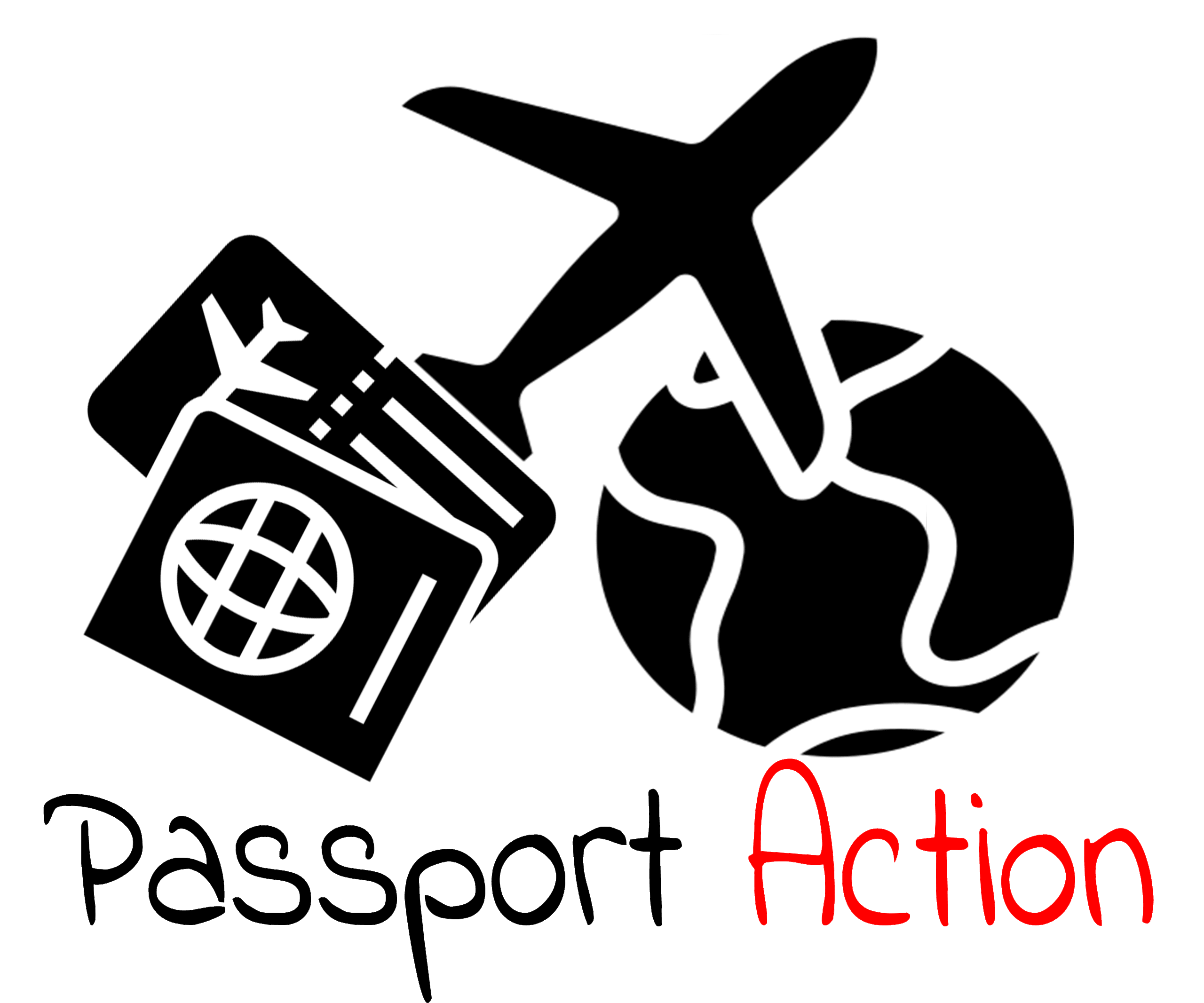The Majestic Mural das Etnias: The Largest Graffiti Mural In The World
The vibrant city of Rio de Janeiro, Brazil, is home to many iconic sights, but none are quite as breathtaking as the Mural das Etnias. This stunning piece of street art once held the distinguished title of being the largest graffiti mural in the world. The colossal 32,300-square-foot canvas, located on Rio’s bustling Olympic Boulevard, is a testament to the transcendent power of art.
The Faces of Mural das Etnias
The Faces of Mural das Etnias is a vibrant graffiti mural that represents unity and diversity through the depiction of five faces from five different continents. Each face symbolizes the indigenous people from these continents, embodying the harmonious coexistence of diverse ethnic backgrounds, and underscoring the message “Todos Somos Um” (We are all one).
The Mursi of Ethiopia: Africa’s Rich Tapestry
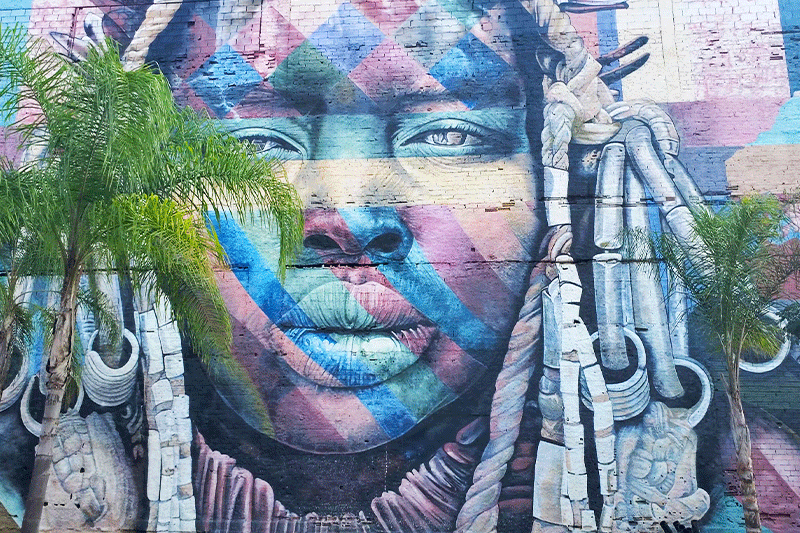
Starting from the left, the first face on the mural represents the Mursi tribe of Ethiopia, a testament to the rich cultural heritage of Africa. The Mursi are known for their unique customs and strength, beautifully captured through the vivid colors and intricate patterns used by Kobra in his mural.
The Mursi tribe is one of the most distinctive tribes in Ethiopia, known for their unique cultural practices and traditions. They reside primarily in the southwestern region of the country, in the remote Omo Valley. The Mursi are seminomadic pastoralists, relying on livestock herding and subsistence farming for their livelihood. They are perhaps most recognized for their body modification practices, particularly the lip plates worn by Mursi women. These clay plates, inserted into a lower lip piercing, are considered a sign of beauty and maturity. Despite increasing external pressures, the Mursi tribe continues to maintain their traditional way of life, offering a glimpse into an ancient culture largely untouched by modern influences.
The Karen of Thailand: Asia’s Diverse Heritage
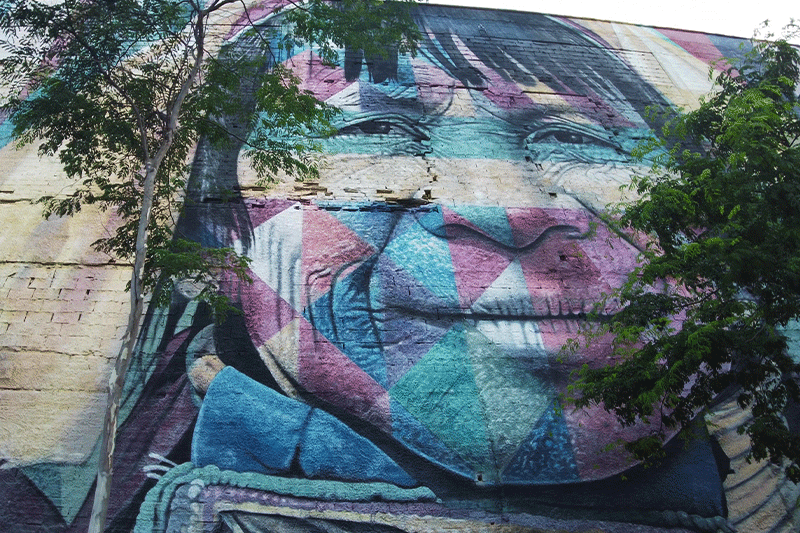
Next, we move to the continent of Asia, represented by the Karen people of Thailand. Known for their resilience and rich cultural traditions, the Karen people add depth and variety to the mural. Their vibrant culture is brought to life through the elaborate patterns and vivid colors used in this section of the mural.
The Karen people, also known as Kayin, are one of the largest hill tribes in Thailand, primarily residing in the mountainous regions along the Thai-Myanmar border. Known for their vibrant culture and rich traditions, the Karen people lead largely agrarian lives, cultivating crops such as rice and vegetables. They are also renowned for their intricate woven textiles and distinctive silver jewelry. Perhaps one of the most recognized groups within the Karen community are the Padaung, often referred to as the ‘long-neck’ tribe, where women wear brass rings around their necks as part of their cultural identity. Despite facing numerous challenges, including displacement and conflict, the Karen people have managed to preserve their unique customs and traditions, contributing significantly to the cultural tapestry of Thailand.
The Tapajos of Brazil: South America’s Indigenous Roots
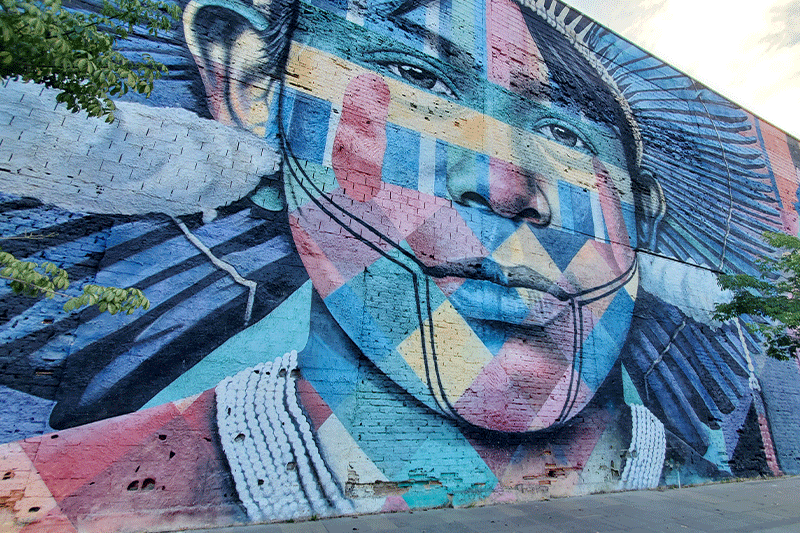
The third face on the mural brings us to the continent of South America, represented by the indigenous Tapajos people from Brazil. This section pays tribute to the continent’s indigenous tribes, whose history and culture are deeply intertwined with nature. The use of vibrant colors captures the essence of South America’s lush landscapes and vibrant traditions.
The Tapajós people are an indigenous group residing in the Tapajós River basin in the Amazon Rainforest of Brazil. Their lives are deeply entwined with the river and the surrounding rainforest, from which they derive their livelihoods through fishing, hunting, and traditional agriculture. Known for their rich cultural heritage, the Tapajós people have unique customs, rituals, and art forms, many of which are centered around their profound spiritual connection to the natural environment. Despite facing threats from deforestation and encroachment on their lands, the Tapajós people continue to fight for their rights and work towards preserving their traditional ways of life and the ecological diversity of their homeland.
The Sami of Northern Europe: A Blend of Traditions
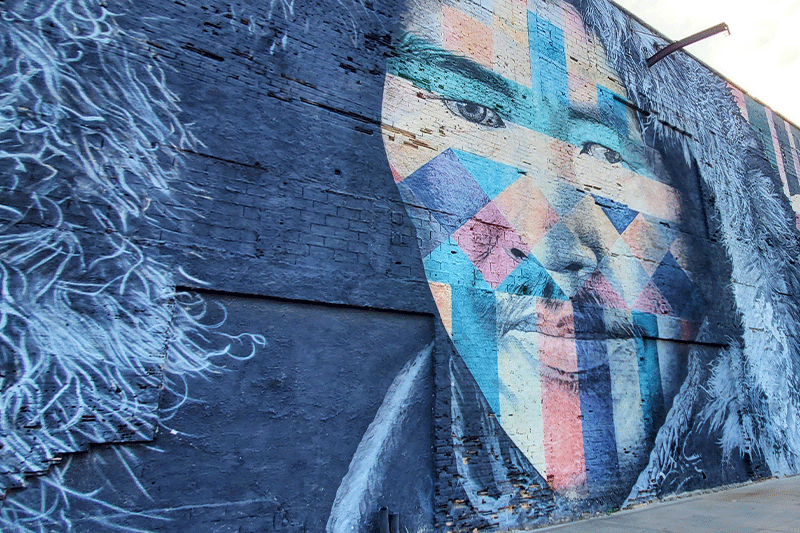
Moving further right, the fourth face on the mural depicts a member of the Sami people from Northern Europe. This face adds a touch of European history and tradition to the mural. The blend of colors used in this section reflects the diversity and richness of cultural practices across the continent.
The Sami people are an indigenous group from Northern Europe, spread across four countries: Norway, Sweden, Finland, and Russia’s Kola Peninsula. They have a rich cultural heritage that dates back thousands of years, with traditions deeply rooted in the harsh, yet beautiful Arctic environment they inhabit. The Sami people are traditionally known for their semi-nomadic lifestyle, primarily engaging in reindeer herding, fishing, hunting, and gathering. Their unique language, Sami, has several dialects and is part of the Uralic linguistic group. Despite facing challenges related to land rights and cultural assimilation, the Sami people continue to preserve their traditions, languages, and way of life, contributing significantly to the cultural diversity of Northern Europe.
The Huli of Papua New Guinea: Oceania’s Vibrant Legacy

Finally, the last face on the mural represents the Huli people of Papua New Guinea, symbolizing the rich cultural heritage of Oceania. Known for their unique customs and colorful traditional attire, the Huli are a testament to Oceania’s diverse cultures. Their culture is brilliantly encapsulated in Kobra’s kaleidoscopic style.
The Huli people are an indigenous tribe residing primarily in the Southern Highlands of Papua New Guinea. Known for their vibrant culture and traditions, they are perhaps most recognized for their elaborate ceremonial attire, especially the iconic wigs made from their own hair, adorned with feathers, and painted with bright yellow and red colors. The Huli society is largely agrarian, with sweet potatoes being a staple crop. They are also renowned for their unique system of tribal warfare and their complex rites of passage for young men. Despite the encroachment of modern influences, the Huli people have managed to preserve much of their traditional way of life, providing a fascinating glimpse into one of the world’s diverse indigenous cultures.
Walking Tour Video Of Mural das Etnias
I did a walk-through showing the world-famous Mural das Etnias. You can see how huge the mural is and how close in proximity it is to the Museum of Tomorrow just incase you want to go and see the mural for yourself.
The Artist Behind the Masterpiece
Eduardo Kobra, the mastermind behind the Mural das Etnias, is a renowned graffiti artist originating from São Paulo, Brazil. Known for his vibrant use of colors and intricate designs, Kobra has made a significant impact on the global street art scene. His works have garnered international attention, transcending the boundaries of his home country and captivating audiences worldwide.
Kobra’s iconic creation, the Mural das Etnias, was painted in honor of the 2016 Rio Olympics. This large-scale work was later recognized by the Guinness Book of Records as the world’s largest mural completed by a single individual. This recognition not only attests to Kobra’s artistic talent but also highlights his ability to create expansive works that captivate and inspire global audiences.
Beyond its impressive size and visual appeal, Kobra’s art carries a deeper, more profound message. The phrase ‘Todos somos um’ (We are all one), prominently featured in the Mural das Etnias, reflects Kobra’s belief in unity and equality among all people, regardless of their cultural backgrounds or ethnicities.
Kobra’s influence extends far beyond the streets of São Paulo. His artwork has been showcased on various international platforms, inspiring emerging artists and art enthusiasts around the globe. Despite his international acclaim, Kobra remains deeply connected to his roots, often integrating elements of Brazilian culture and history into his artwork.
The legacy that Eduardo Kobra has built within the realm of graffiti art is undeniable. His ability to transform urban landscapes into vibrant, thought-provoking murals has solidified his place among the world’s leading street artists. As the creator of the world’s largest graffiti mural, Kobra continues to push the boundaries of street art, leaving a lasting impact on communities and individuals alike.
More Than Just a Nice Mural
The Mural das Etnias is not just an aesthetically pleasing display of art, but it’s also an impactful representation of human diversity and unity. Painted by Eduardo Kobra, this mural features indigenous people from each continent, signifying the richness of cultural variety worldwide. It stands as a symbol of our shared humanity, stressing that despite our varied cultural backgrounds and ethnicities, we all belong to one global family.
This colossal masterpiece, spreading over 3,000 square meters, is more than just a marvel of artistic endeavor; it’s a demonstration of how art can be used to convey significant social messages. Its sheer size, vibrancy, and the depth of its theme command attention, turning a simple city wall into a canvas that sparks conversations about diversity, unity, and mutual respect.
Furthermore, the Mural das Etnias serves as an exemplar of transformative public art. By turning an urban space into a piece of art, it has not only beautified the city but has also brought a sense of pride to its residents. It shows how art can be a powerful tool for urban renewal, fostering community engagement and transforming public perception of spaces.
Beyond its striking visuals, the mural carries a potent message of unity in diversity. The phrase ‘Todos somos um’ (We are all one) is prominently depicted, reflecting Kobra’s belief in universal brotherhood. This message fosters a sense of global citizenship, promoting the idea that understanding and respecting cultural diversity is crucial in today’s interconnected world.
Finally, the Mural das Etnias is a testament to the power of creativity and dedication. The mural, was once acknowledged by the Guinness World Record as the largest graffiti mural in the world, showcases Kobra’s extraordinary talent and commitment to his craft. It serves as an inspiration to aspiring artists, proving that art is a potent medium for expressing ideas and shaping societal perceptions. The Record has now been surpassed by another mural created by Kobra.
Preserving The Legacy Of Murals
Since its creation in 2016, the Mural das Etnias, a vibrant tribute to global diversity, has unfortunately experienced a noticeable fading of its once vivid colors. The brilliant hues that initially brought the indigenous faces from around the world to life have gradually dulled over time. This natural weathering process has somewhat diminished the visual impact of the mural, yet it continues to captivate audiences with its powerful message.
The fading of the mural’s colors can be attributed to several factors. Being an outdoor artwork, the mural is constantly exposed to the elements, including sunlight, rain, and pollution. Over time, these environmental factors have taken a toll on the pigments used in the paints, causing them to lose their original vibrancy. Even the highest quality paints are susceptible to these effects, and the Mural das Etnias is no exception.
Despite the fading, the mural’s intricate details and the profound meaning behind it remain intact. The faces representing different ethnicities may have lost some of their brilliance, but their expressions and the unity they symbolize continue to resonate with viewers. The fading colors, in a way, add a layer of depth to the mural, serving as a poignant reminder of the passage of time and the enduring nature of art.
Interestingly, the fading colors have also sparked discussions about the preservation of public art. While some believe that the natural weathering process adds a unique character to the artwork, others argue for regular maintenance to preserve the original vibrancy of the mural. This debate reflects the broader question of how best to balance the dynamic, ephemeral nature of street art with the desire to preserve these cultural landmarks for future generations.
In spite of the color fading, the Mural das Etnias remains one of the most significant works of Eduardo Kobra. Its grand scale, intricate design, and powerful message continue to inspire and provoke thought among its viewers. Even as the colors fade, the mural stands as a testament to the enduring power of art to reflect societal diversity and promote unity.
Legacy of the 2016 Olympics
The Mural das Etnias, also known as “We Are All One,” was created by renowned Brazilian street artist Eduardo Kobra as part of the 2016 Olympics held in Rio de Janeiro. This monumental mural, extending over 3,000 square meters, was an integral aspect of the city’s cultural offering during the global sporting event. It served as a vibrant backdrop to the games, encapsulating the spirit of unity and diversity that defines the Olympic ethos.
Situated in the bustling port district of Rio, the mural was strategically placed to capture the attention of thousands of athletes, visitors, and residents who were part of the Olympic festivities. Its creation was a significant cultural endeavor undertaken in conjunction with the Olympics. The mural, showcasing indigenous people from five continents, was a colorful representation of the global gathering happening in Rio, emphasizing the shared humanity transcending geographical boundaries and cultural differences.
During the Olympics, the Mural das Etnias became a popular attraction, drawing crowds who marveled at its intricate details and vibrant colors. It provided a powerful visual experience that complemented the athletic prowess on display during the games. Just as the Olympics brought together athletes from diverse backgrounds to compete under one banner, the mural highlighted the beauty and strength inherent in global diversity.
Beyond the spectacle of the games, the mural left a lasting cultural legacy for Rio de Janeiro. Long after the athletes had gone home and the Olympic flame was extinguished, the Mural das Etnias remained, serving as a permanent reminder of the unity and diversity celebrated during the 2016 Olympics. This enduring piece of public art continues to inspire locals and visitors alike, reminding them of the city’s moment in the global spotlight.
In Conclusion: “Mural Das Etnias” The Largest Graffiti Mural In The World
The creation of the Mural das Etnias as part of the 2016 Olympics held in Rio de Janeiro was more than just an artistic endeavor; it was a statement about the power of unity, the beauty of diversity, and the transformative role of art in society. It continues to stand as a symbol of the global camaraderie that was celebrated during the games, making it an integral part of Rio’s Olympic legacy.
I highly recommend taking some time out of your trip to Rio De Janeiro and checking out the mural. You can find it within walking distance of the Museum of Tomorrow. Located in the center of Rio. The street name is Olympic Blvd. Make sure to check out my list of Things to do in Rio de Janeiro.
